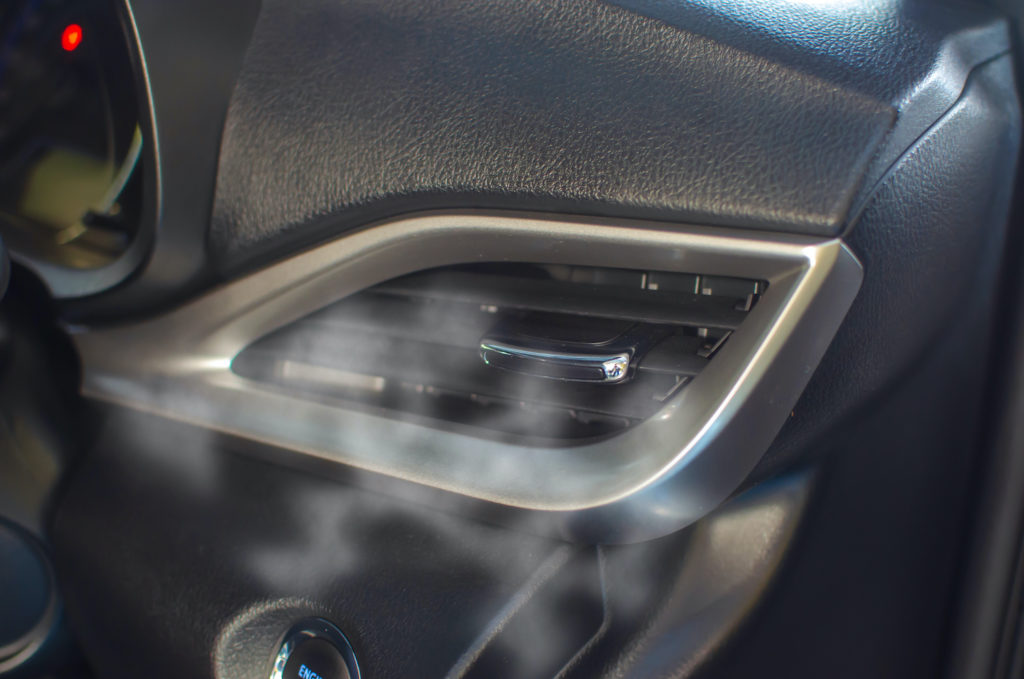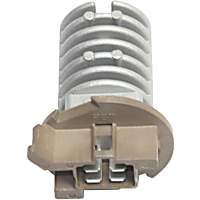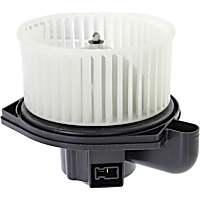A very common issue with blower resistors is a burned out connector. Blower resistor terminals can develop resistance, and when they do, they get hot and begin to oxidize even further, creating large amounts of resistance where no resistance should be, heating the wire terminals and the wires feeding them until they scorch and melt the blower resistor connector. Eventually, the connector terminals become so damaged and oxidized that the blower stops working or perhaps you might notice that it only works when you wiggle the wires at the resistor connector.
Usually a simple visual inspection will reveal this kind of failure – the wires at the connector will be blistered and scorched with missing insulation, and sometimes the melting is severe enough that the connector may be fused to the blower resistor and can’t be unplugged.
This kind of failure requires replacing the resistors as well as the resistor connector pigtail, but you need to do a really good job splicing the wires (and don’t get them out of order) or you’ll make bigger problems for yourself.
(A burned out blower motor resistor connector) requires replacing the resistors as well as the resistor connector pigtail, but you need to do a really good job splicing the wires (and don’t get them out of order) or you’ll make bigger problems for yourself.
–Richard McCuistian, ASE Certified Master Automobile Technician
This meltdown type failure can also happen at the blower motor connector itself.
Blower Motor Resistor Test

Okay, let’s say there’s no melting going on, but your fan doesn’t work on all speeds. Typically, if the fan will work on some speeds but not on others, the resistor is suspect. If the fan won’t work on any speeds except high speed, the blower resistor’s thermal fuse may have failed, meaning the entire resistor needs to be replaced.
WARNING: Do NOT bypass the blower resistor thermal fuse if you don’t want your car to catch fire!
Here are some tips on how to test your blower motor resistor:
- Start by looking for the blower fan resistor. A repair manual can tell you where its location is in your vehicle’s make and model.
- Inspect the resistor visually. Look for obvious signs of corrosion and burns from overheating. If you see signs of overheated connectors, replace the blower resistor and its connector, but again, you must splice the wires right, or you’ll have problems at the splice later on.
- If you want to do a quick test of the blower resistor, you can check the resistance of each of the resistors with a multimeter as follows: set the tool to read ohms (a measurement of resistance) and connect one of its probes to the common output terminal of the resistor. Use the other probe to measure the resistance between the output terminal and each of the resistor’s input terminals. Measure the resistance between one pair of terminals at a time. Of course, to do this, you need to know which terminal is the common terminal (it’s the one directly feeding the fan motor). And you’ll also need to know which of the other terminals is which speed – you can find this information in an online wiring schematic for your vehicle if you know where to look.
- If any of the points show infinite resistance, the blower motor resistor has failed. Infinite readings denote an open circuit.

Be careful when handling the blower resistor. Since electric currents pass through the resistor for extended periods, the device can build up significant heat—enough to burn your fingers or worse.
What is a Blower Motor Resistor and What Does it Do?
The blower motor resistor controls the fan speed of the blower motor and the resulting change in air pressure produced by the movement of the blower fan. It accomplishes this by regulating the electric current that powers the motor.
How Does a Blower Motor Resistor Work?
On climate control systems without automatic temperature controls, the blower motor speeds are controlled by a switch wired to a stepped resistor that usually includes a thermal fuse. Because resistance creates heat while current is flowing, the blower resistor is mounted in the duct near the blower motor so the resulting airflow will keep the resistor cool.
If the fan malfunctions (like if the fan shaft is spinning in the blower cage hub without spinning the cage) so that no air is moving past the resistor but current is still creating heat in the resistor pack, the thermal fuse that is integral to the resistor assembly opens the electrical circuit to prevent the resistor(s) from getting too hot.
To understand how the blower resistor works, a simple electrical principle called “voltage drop” is used. When a switch, a resistor, and a load are wired in series, the resistor “drops” some of the voltage passing through it, effectively reducing both current flow and voltage at the motor. A voltmeter connected to both ends of a resistor while current is passing through it to a load will measure the amount of voltage being “dropped” by the resistor. Because lower voltage means lower current delivered to the fan, the stepped resistor circuit can be used to control fan speed.
The blower switch and its gang of resistors are wired so that when the blower switch is set at the lowest speed, the maximum amount of voltage is dropped and the least amount of current is fed to the motor because it is passing through an entire series of resistors – for our purposes we’ll say there are three resistors.
In the next highest speed, one of the three resistors is bypassed and since the voltage is only having to push the current through two resistors, the fan motor runs a bit faster. In the next highest speed, two of the three resistors are bypassed and only one resistor remains in series with the motor (load).
Finally, with the fan switch on the highest speed, the fan motor is receiving system voltage (14.5 with the engine running). Some systems will energize a relay when the switch is set at the highest fan speed. The relay then closes its contacts, feeding full voltage to the fan, because a relay can handle the current better than the fan switch.
What are the Symptoms of a Bad Blower Motor Resistor?
Every time you fiddle with the fan speed of your car’s air conditioning or heating system, you change the current that flows through the blower motor resistor on the way to the blower motor.
A bad or failing blower motor resistor hampers the efficiency of the heating and air conditioning system. The most common symptoms include:
The Blower Only Works on Higher Speeds
A working resistor can shift between speed settings according to the user’s preference. If one of the resistors is burned out, the only speeds that will work are the speeds above the burned out resistor.
A blower stuck on a high-speed setting will keep blasting you with hot or cold air when you don’t need it, though one that’s stuck on the low setting can be just as frustrating.
This symptom isn’t limited to a bad blower motor resistor. A broken blower motor switch can also stop the blower from changing to certain speed settings. If your blower motor cannot change to certain speeds, check both the resistor and the switch on your dashboard. The most common failure points are the resistor and the motor itself.
No air comes out of the vents
There are instances where a bad resistor will prevent the current from reaching the blower motor altogether. Without any power, the motor won’t run. As a result, the blower fan stays still and silent, and no air blows out of the vents.
This symptom can also stem from a failed blower fan or several other issues, such as:
- Burned connectors or thermal fuse failure
- Blown fuse or circuit breaker
- Faulty switch or wiring
- Bad ground
Causes of a Bad Blower Motor Resistor
Resistors have it rough. They always have electricity flowing through them, and the voltage can change sharply as you adjust the strength of the blower fan.

The most likely reasons for blower motor resistor failure include:
- Corrosion from long exposure to air and moisture
- Overheating—if a motor finds it harder to move because of jamming or worn bearings, it can raise the resistor’s temperatures to dangerous levels.
- Normal wear due to time and use
What is the Cost of a Replacement Blower Motor Resistor?
You can still drive your car despite a faulty blower motor resistor. However, you’ll probably find it uncomfortable to have the blower running at one speed setting the entire time or having limited access to certain settings.
Depending on the manufacturer and model, a blower motor resistor can go anywhere between $3 and $335 on CarParts.com. The replacement parts come in individual units, sets of two resistors, or as part of a blower motor resistor kit.
Products Mentioned in this Guide
Any information provided on this Website is for informational purposes only and is not intended to replace consultation with a professional mechanic. The accuracy and timeliness of the information may change from the time of publication.



 Blower Motor Resistor
Blower Motor Resistor
 Blower Motor
Blower Motor




























Have a 2010 Lincoln Navigator… climate control blower stuck on one speed (seems to be medium-high) fan speed controls not working to lower speed… and hitting off button actually seems to increase the speed. Bought a replacement speed control module/resistor from auto value [house brand] that says it is the same as a Ford speed control. Removed old speed control module (wires, connector all are fine)… installed AutoValue speed control module/resistor and engaged HVAC… blower still on one speed and off button still not working. What now???
Hi Tony,
I’m assuming your vehicle has dual automatic temperature control. It’s possible that there’s a problem with the HVAC control module or its circuit. The HVAC module provides a pulse-width modulated signal to the blower motor speed controller to control blower speed. If you’re set on fixing the problem yourself, I recommend consulting a repair database for the blower motor pinpoint tests. You can learn more about accessing a repair database in this article: https://www.carparts.com/blog/why-you-should-always-consult-a-repair-manual/
I have a 1995 Ford explore with automatic heat and air controls. We had to replace the heater ore assembly and after all that work everything was working and about 10 minutes later the controls went blank and stopped blowing. When it hasn’t been used for a day everything works for about 10 minutes and the dash controls no longer light up and stops blowing we can feel heat coming out of the defrost vents. We changed the blower relay and that didn’t help. If we ground the resistor on the side of the vehicle it blows. Can you help?
Hello Dawn,
As I’m sure you’re aware, the entire dashboard must be removed to replace the heater core on your vehicle. Since the problem started happening AFTER you had the core replaced, it seems like something might have gotten disturbed during the repair.
Since you said the blow motor works when you ground the resistor, I would check ground G102. It’s located on the righthand side of the engine compartment, attached to the right quarter panel. According to the diagram I have, it looks like that’s also the ground for the HVAC control module, which might be why the unit intermittently goes blank.
Thank you! We will check that out and let you know what happens!
Ok so he went and looked and everything is all hooked up. How would you know if it’s the dashboard controls are going? It does have automatic controls (no knobs)
Hi Dawn,
Maybe I misunderstood — didn’t you say you got the blower motor to work by grounding the resistor (speed controller)? The control unit (dashboard controls) provides a voltage signal to the speed controller, not ground.
I have a 1988 mercedes 420sel. The blower motor resistor terminals look a little oxidized which after reading your article sounds like a possible culprit. I have checked the power lead to the blower and it has power. My questions are; 1- is the resistor still possibly the culprit for the blower not working? 2- would cleaning the resistor terminals help to resolve the issue?
Hello Dave,
On your vehicle, the electronic blower control unit (resistor) supplies power to the blower motor. So, if you have power to the motor, the control unit is probably okay. As for the oxidized terminals, it’s possible they’re creating a high-resistance problem within the blower motor circuit. However, a failed blower motor is a far more likely cause for your concern. Have you tried jumping the blower motor to see if it works?
I have a 2013 Chevy Silverado. This vehicle has a feature that turns down the blower motor and stereo volume when receiving a call via Bluetooth. A couple of times after ending a call my blower motor didn’t return to the speed it was at prior to the call although the stereo volume returns. I was able to “fix” this by disconnecting the battery which seemed to reset the blower motor. Seeing that the Bluetooth calls were causing this I removed my vehicle from my phone’s Bluetooth. Recently the blower turned off with no call causing it and now doesn’t respond to any fan speed setting. I’ve checked all fuses and have tested the blower motor with a jumper wire (the motor turns on and fan cage turns seeming to work as intended). Could this still be a resistor problem or am I seeing a problem with the Bluetooth call turn down feature?
Hello,
On your vehicle, the blower motor’s speed is controlled by the blower control module based on inputs from the HVAC control module. It’s very possible that the blower motor control module is to blame, but there are also other possibilities, such as a wiring issue or a problem with the HVAC control module. We recommend getting a professional, in-person diagnosis for a definitive answer.
i have a 2015 nissan altima blower motor works on high sometimes and at times it only works on the lower speeds could it be the resister ?